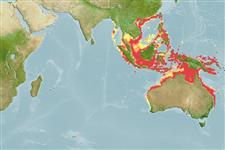Common names from other countries
Environment: milieu / climate zone / depth range / distribution range
Ecologia
marinhas; Água doce; estuarina demersal; intervalo de profundidade 0 - 100 m (Ref. 6871). Tropical; 28°N - 32°S, 76°E - 165°E (Ref. 114953)
Indo-West Pacific: Thailand to New Guinea and the Solomon Islands, south to Australia. Records from the south coast of India, Sri Lanka, Bangladesh, and Myanmar need confirmation.
Comprimento de primeira maturação / Tamanho / Peso / Idade
Maturity: Lm 165.0, range 150 - 180 cm
Max length : 270 cm TL macho/indeterminado; (Ref. 9909)
Occurs inshore and offshore, from the intertidal to offshore continental and insular shelves (Ref. 9909). Adults are found offshore waters while young individuals are found inshore on sand flats, around atolls, and in mangrove swamps (Ref. 6871). Feeds on shellfish, mainly on prawns and crabs (Ref. 9909, Ref. 114953). Ovoviviparous (Ref. 50449). Maturity size at 150-180 cm TL; born at 38-40 cm TL (Ref. 114953). Reported to live and breed permanently in fresh water (Ref. 6871). Probably the major commercial guitarfish in the Western Central Pacific (Ref. 9909). Caught regularly by demersal tangle net fisheries operating throughout the area. Utilized for its meat, fins (both very high value), skin and cartilage (Ref.58048). Reported to attain a maximum length of 4 m (Ref. 58784).
Ciclo de vida ou comportamento de acasalamento
Maturidade | Reprodução | Desova | Ovos | Fecundidade | Larvas
Exhibit ovoviparity (aplacental viviparity), with embryos feeding initially on yolk, then receiving additional nourishment from the mother by indirect absorption of uterine fluid enriched with mucus, fat or protein through specialised structures (Ref. 50449). Born at 38-40 cm TL (Ref.58048).
Last, P.R. and J.D. Stevens, 1994. Sharks and rays of Australia. CSIRO, Australia. 513 p. (Ref. 6871)
Status na Lista Vermelha da UICN (Ref. 130435)
Uso pelos humanos
Pescarias: pouco comercial; Aquário: Espécies comerciais
Mais informação
Idade/TamanhoCrescimentoPeso-comprimentoComprimento-comprimentoFrequências de comprimentoMorfometriaMorfologiaLarvasDinâmica larvalRecrutamentoAbundância
ReferênciasAquaculturaPerfil para aquaculturaEstirpesGenéticaElectrophoresesHereditariedadeDoençasProcessamentoConversão de massa
Ferramentas
Relatórios especiais
Baixar XML
Fontes da internet
Estimates based on models
Preferred temperature (Ref.
115969): 25.7 - 29, mean 28 (based on 1126 cells).
Índice de diversidade filogenética (Ref.
82804): PD
50 = 0.5156 [Uniqueness, from 0.5 = low to 2.0 = high].
Bayesian length-weight: a=0.00389 (0.00138 - 0.01094), b=3.05 (2.82 - 3.28), in cm Total Length, based on LWR estimates for this (Sub)family-body shape (Ref.
93245).
Nível Trófico (Ref.
69278): 3.6 ±0.50 se; based on food items.
Resiliência (Ref.
120179): Baixo, tempo mínimo de duplicação da população 4,5 - 14 anos (Fec assumed to be <100).
Fishing Vulnerability (Ref.
59153): Very high vulnerability (90 of 100).
